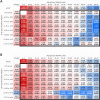Longitudinal analysis of 5-year refractive changes in a large Japanese population
- PMID: 35190604
- PMCID: PMC8861094
- DOI: 10.1038/s41598-022-06898-x
Longitudinal analysis of 5-year refractive changes in a large Japanese population
Abstract
Refractive changes are reportedly affected by age, sex, and current refractive error. To clarify the pattern of refractive changes in a Japanese population, we conducted a 5-year follow-up longitudinal analysis of spherical equivalent (SE) refractive changes with stratification by sex, age, and SE in 593,273 eyes from Japanese individuals ages 3-91 years. The 5-year SE change with myopic shift dramatically increased over time after age 4 years, and the largest change was observed in both males and females who were age 8 years at baseline [males: - 2.654 ± 0.048 diopters (D); females: - 3.110 ± 0.038 D]. During school age, the 5-year myopic change was greater in females than in males, and emmetropic and low-to-moderate myopic eyes underwent larger myopic changes than hyperopic and high-to-severe myopic eyes. After the peak at age 8 years, the 5-year myopic change gradually declined with age and fell below - 0.25 D at age 27 in males and age 26 years in females. The 5-year SE changes transitioned from a myopic to a hyperopic shift at age 51 in both sexes, and hyperopization advanced more quickly in hyperopic eyes. Our findings highlight the importance of myopia prevention in school-aged children.
© 2022. The Author(s).
Conflict of interest statement
M.T., T.Y., K.Y., E.O., and N.M. are listed as inventors on a patent (WO2018003672) related to the expansion technology developed using the results of this manuscript. A.M. and M.Y. declare no competing interests.
Figures


References
-
- Modjtahedi BS, Ferris FL, 3rd, Hunter DG, Fong DS. Public health burden and potential interventions for Myopia. Ophthalmology. 2018;125:628–630. - PubMed
-
- Saw SM, Gazzard G, Shih-Yen EC, Chua WH. Myopia and associated pathological complications. Ophthalmic Physiol. Opt. 2005;25:381–391. - PubMed
-
- Fan DS, et al. Prevalence, incidence, and progression of myopia of school children in Hong Kong. Invest. Ophthalmol. Vis. Sci. 2004;45:1071–1075. - PubMed
-
- Zhao J, et al. Refractive error study in children: Results from Shunyi District, China. Am. J. Ophthalmol. 2000;129:427–435. - PubMed
-
- Kempen JH, et al. The prevalence of refractive errors among adults in the United States, Western Europe, and Australia. Arch. Ophthalmol. 2004;122:495–505. - PubMed
Publication types
MeSH terms
LinkOut - more resources
Full Text Sources
Medical

